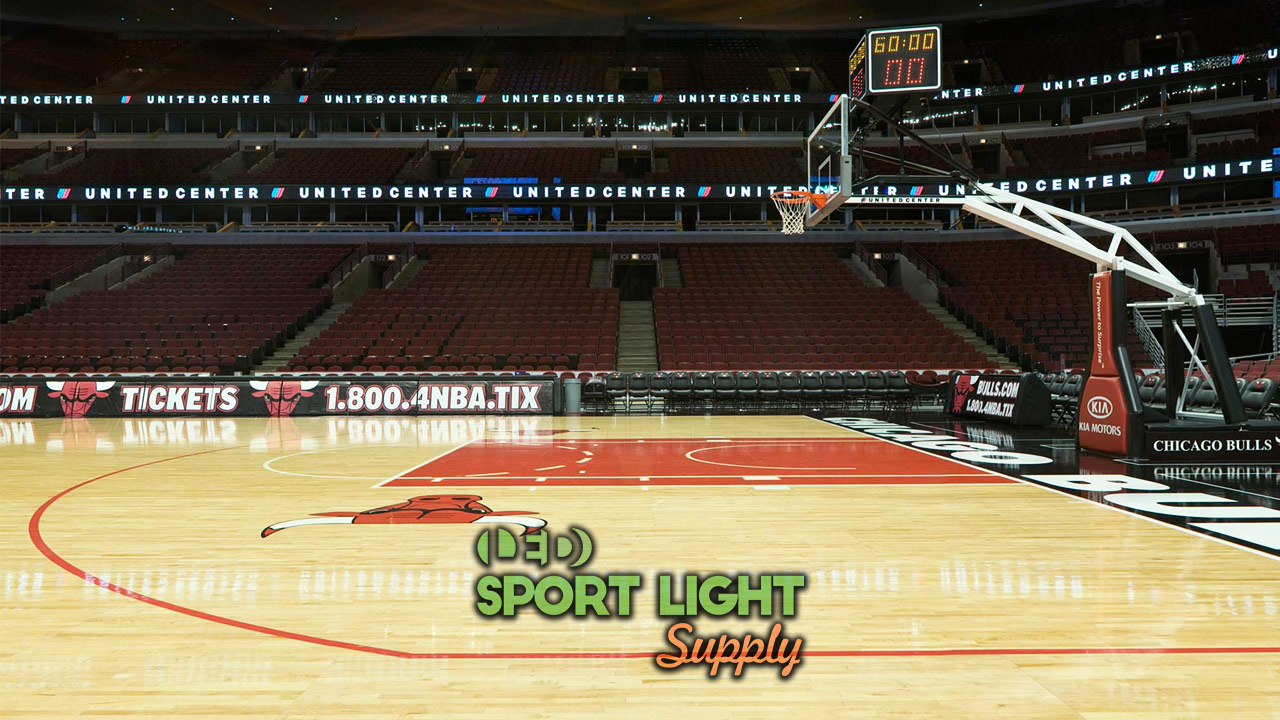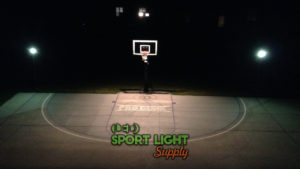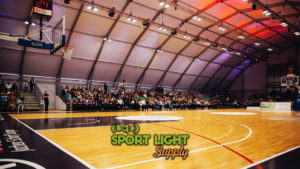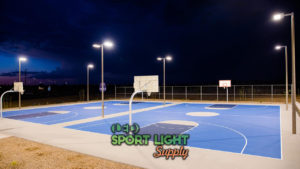Only the most suitable lighting system for your basketball arena will operate at a low running cost. At first, such a statement may sound contradictory. But as you will quickly see, replacing all the old fixtures with LED is not enough.
To help you grasp all the key aspects fully, this brief guide divides the whole discussion on budget and expenses into four topics. An overview of different categories of lighting systems opens with the initial and mandatory proceedings. After that, we will delve into the most critical factors that affect the basketball lighting outlay.
The last two sections will give you some numbers and estimates. As a basketball stadium owner, budget planning is a vital activity. Thus, we will tackle the electricity fees and how much expensive the equipment can get. Plus, some tips to save more money, of course.
The average cost of basketball court lighting
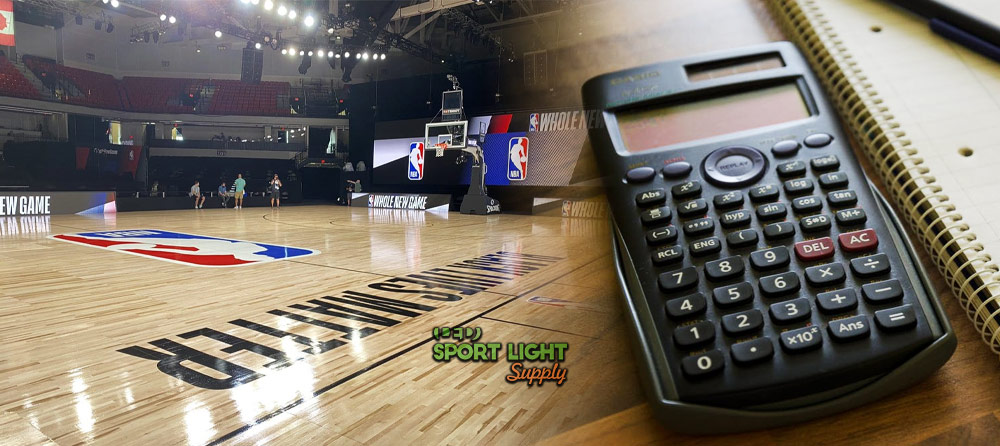 Before calculating an average, you need to find the upper and lower limits within a specific range. Well, when it comes to lighting, basketball associations dictate such limits. The lighting requirements are absolute standards that you need to know.
Before calculating an average, you need to find the upper and lower limits within a specific range. Well, when it comes to lighting, basketball associations dictate such limits. The lighting requirements are absolute standards that you need to know.
Each lighting system must provide adequate brightness for varying levels of competition. As you move up in competitive levels, more fixtures must satisfy more criteria. For example, televised basketball games must generate profits for the broadcasting companies. These investors want you to employ the best lighting equipment. And they need you to comply with their guidelines for optimal video recording.
Illumination quality is critical for spectators too. During national basketball league events, sponsors want you to entice the audience into associating an enjoyable evening or afternoon with their brand or services. All sorts of ends extend beyond the physical LED lights. Goals that come into play the higher you set your bar.
1. Class I
Power consumption for lighting indoor basketball courts depends on the lux requirement. So, the first step is calculating the total amount of lumens necessary to satisfy this criterion.
While the lumen (lm) is the unit for light intensity, the lux describes illuminance. That is, brightness quantity on the given playing surface. LED lights prevent fluctuations in luminous output. But as you move the light sources in space, the illuminance level on the desired area changes.
International basketball games and top-tier league events like All-Star Games fall under the label of Class I. Simply put, you can ascribe any televised basketball game to this category.
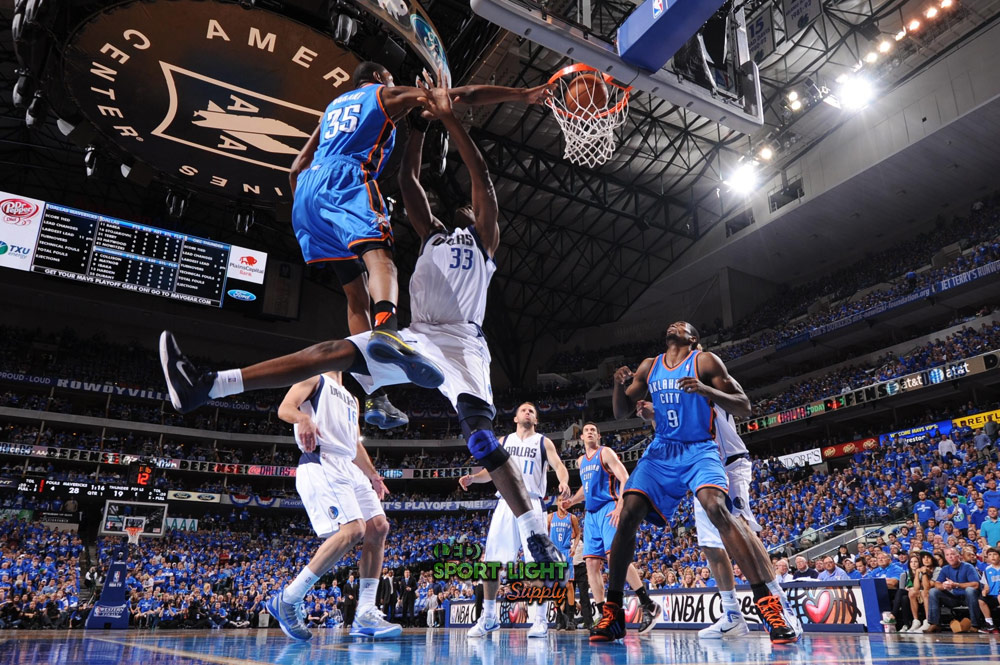
The average cost of LED lights for Class I
The lux standard for Class I events is 750lux, which is equivalent to 750 (lux) x 436 (a standard court area in sq. meter) x 1.2 (light loss factor) = 392,400 lm.
Now, let’s estimate wattage of all the LED basketball court lights required. Roughly, we can assess that we need 392,400 lm / 170 lm per watt = 2,308 watts. Of course, only a high-quality light source produces 170 lm per watt.
Regarding the basketball court fixtures, the price for equipping the whole lighting system ranges between $1,150 and $3,450 per court. In other words, consider a cost for the basketball court lighting around $0.5 to $1.5 per watt.
2. Class II
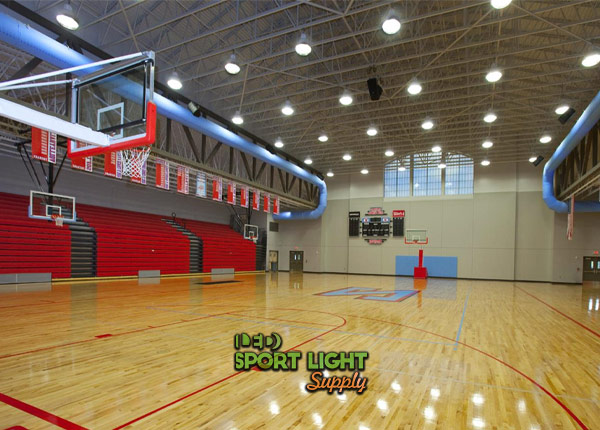 The technological installations for regional basketball league championships have lower energy requirements. In the same way, the lux standard drops to 500 lux. The artificial lighting of such a basketball court thus contributes to supporting safe sports activities and enjoyable matches.
The technological installations for regional basketball league championships have lower energy requirements. In the same way, the lux standard drops to 500 lux. The artificial lighting of such a basketball court thus contributes to supporting safe sports activities and enjoyable matches.
On many occasions, basketball exhibitions inspire young and promising players. Plus, these non-televised matches have a significant impact on the stadium profits. This is why a specific sports lighting class exists for this competition level.
Class II includes local competitions as well. But some basketball associations consider the latter ones as Class III activities. So, always refer to your association for guidance and support.
The average cost of LED lights for Class II
First of all, the total lumens to illuminate the court are 500 (lux) x 436 (sq. meter) x 1.2 (light loss factor) = 261,600 lm. As the number of fixtures drops, planning the lighting layout becomes critical. Mainly because it must provide enough lighting uniformity at the same time.
Most likely, wattage is around 261,600 lm / 170 lm per watt = 1,539 watts. I kept the same lumen per watt efficiency for convenience. At any rate, cost-efficient luminous efficacy will further reduce wattage.
If you want to give your spectators thrills similar to most prestigious playoffs, expect to pay up to $2,850 for LED fixtures. In any case, an unavoidable expense of at least $800 is in order. You may find cheaper LED sports light manufacturers. But the overall quality is often shoddy below this threshold.
3. Class III
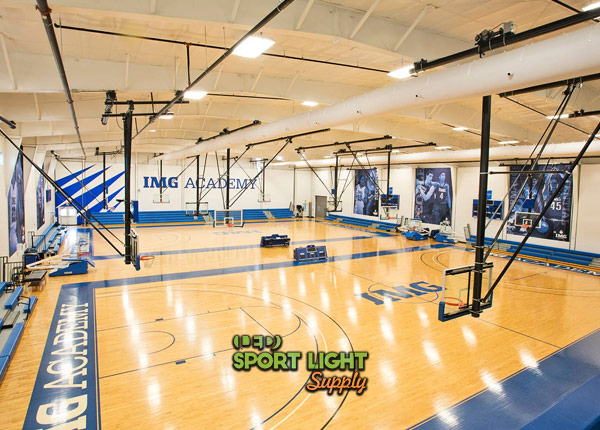 The last lighting class includes training sessions and low-level competitions. For example, local club matches without spectators. Of course, such a minimal standard is highly suggested for leisure activities as well.
The last lighting class includes training sessions and low-level competitions. For example, local club matches without spectators. Of course, such a minimal standard is highly suggested for leisure activities as well.
The average cost of LED lights for Class III varies at around $200-500 for the lighting equipment. Since the lux requirement is only 200 lux, a standard basketball court needs 104,640 lumens. The formula is 200 (lux) x 436 (sq. meter) x 1.2 (light loss factor).
However, for recreational activities, you might end up using a smaller playing field. This means that the total lumen output can be considerably lower.
At most, wattage can reach 104,640 lm / 170 lm per watt = 616 watts. If you install high-quality LED flood lights, a few fixtures will ensure optimal horizontal illuminance. Which is the only factor that could influence you during the price comparison.
Factors affecting the basketball stadium light cost
1. Level of competition
Each basketball player dreams of playing at that next level. No matter what role he or she has, a player must do more than throwing the ball in the paint. Of course, shooting remains one of the most critical skills to reach full potential. It makes even a small player successful in basketball. But when the coach decides it is time to make that big next step, the ultimate goal is to rank first and change the level of competition.
As a team climbs the pro basketball league ladder, the lux requirement changes as well. The increase in running expenses will reflect that. But before you can host a pro league match, you might have to buy new lamps or spot lights. Sometimes, you have to design a whole new lighting system.
Besides, you might have to renovate the basketball stadium as well. For example, FIBA requires permanent wood flooring and synthetic flooring for hosting class I and II games. A shiny wooden flooring will reflect more light and may cause more glaring. So, a photometric analysis could be necessary.
2. Basketball court size
Usually, you just need to light up the court. But sometimes, you will need to light up the entire audience seats in an arena. Or you might want to illuminate a portion of the basketball court for training. If you have a standard lighting system, the size of the basketball court may influence the operating cost.
Basketball courts come in different sizes. The NBA requests a court size of 94 by 50 feet. Instead, FIBA applies a smaller standard. Which is 92 by 49 feet (28 x 15 meters). For an outdoor training field, a half-court basketball court might be enough.
A full professional court il longer has bigger dimensions than a regional court. The same goes for the width. So, high school basketball courts are usually smaller. Just so you know, a high school key is 12 feet. In the NBA, the key is 16 feet.
3. Type of lights
In your sports arena, the type of lights you install will influence your budget in the long run. For one thing, lamps like Metal Halides and mercury vapor bulbs may have a low price tag. But they will consume more electricity. Instead, LED lights are cost-effective. Nonetheless, they tend to cost more than traditional lamps.
When comparing several sports lights, LEDs come on top every single time. In fact, older lighting technologies are either banned or obsolete:
- Producing new ballasts for Metal Halide is illegal in many nations. Including the US.
- Some old traditional lights are unsafe. For instance, a mercury-vapor lamp emits harmful ultraviolet rays. Even HPS bulbs list a fire hazard on the labels because of the high operating temperatures.
- While the unit price is lower, the operating cost of traditional light sources is higher. HPS, MH, and MV have a short life span.
Advancements in LED technologies removed every safety hazard. But making these lights remains still more expensive because of the semiconductor materials that a light-emitting diode contains.
Most basketball associations already switched to LED lighting. So, the association’s guidelines may promote a layout designed for LED lighting. After all, LEDs are the most long-lasting products on the market, with the best maintenance factor for optimal illuminance over the years.
4. Installation height
Installing the same light source in a different location may impact how much you pay at the end of the month. In brief, the basketball court lighting cost will be higher if the light poles or ceiling are taller because of the increase of light loss.
When light passes through the glass lens, some of the light is going to be lost. Technicians refer to this light loss as the rate of transmission. Light transmittance is thus what changes when you move the light position up and down.
When you look at something, you do not see the object. In fact, you see the light reflected off of the object’s external surface. But increasing the distance from the light source will disperse more light. So, the higher you install the fixtures, the more lighting devices you will need to compensate and achieve adequate light quality.
The paint on the walls may reflect, absorb or scatter the light. In an outdoor basketball stadium, this factor will influence maintenance costs. This is why you should select long-range and short-range fixtures depending on the stadium or outdoor layout.
5. Lamp origin
The price of each lamp changes when the manufacturers delocalize their production. But generally speaking, in the US, UK, and western countries, a similar LED light model is more expensive than in China and other Asian countries.
Of course, the price also reflects the quality. If you compare US brands with cheaper manufacturers, you will find differences in:
- build quality, plus a warranty that you can claim with no problems
- instruction manuals and setup information
- efficiency (usually, US brands score better during testing)
If you plan to order the lights from abroad, make sure you test the products first. In any case, contact the seller or the manufacturer to get to know the brand. Testing the customer care service in advance will prevent any possible issue from leaving you stuck in a hard place.
Sometimes, buying lamps in bulk can save you a lot of money. Especially if you want to replace the lights in nearby parking lot areas. Or anywhere where the lighting quality is not as critical as on the playing surface. So, if the socket or lamp holder is the same, you can buy a small lot of units.
6. Miscellaneous factors
The lighting uniformity requirement for top-level competition includes vertical uniformity. This means that the fixtures must also illuminate the area above the players’ heads. As you can imagine, the lighting solutions must provide vertical lighting uniformity without causing glare or visual discomfort.
Buying shields or glare-free lights are available. But the price of anti-glare lighting fixtures will affect your budget. Similarly, a lighting control system offers many useful commands.
If you include dimmable lights in your lighting design, light controls will help you lower wattage and reduce light pollution outdoors. That is, if you can afford the upfront cost of the smart control system installation.
In an outdoor basketball court, you will need to install lightning rods. This electric distribution system protects both the fixtures and the players. As well as nearby buildings.
In an indoor stadium, consider improving air ventilation to stave off overheating. Overheating shortens the lights’ life span and increase the maintenance costs.
How much does it cost to run the basketball court lighting?
Besides the initial cost for the equipment, the most recurring expense is the operation cost. For a complete overview of all the costs involved, you need to figure out the life cycle cost. Life cycle cost collects all of the costs related to the basketball court lighting system and analyzes them over the system’s life span. Usually, over its most long-lasting component. Or over the sports facility itself.
When you calculate the life cycle cost, you end up with a single number that you can use to assess your system cost. As well as for comparing new systems, retrofits, and upgrades. The four basic components of life cycle cost are:
- the material, including replacement parts such as a lamp, ballast, or LED driver
- manual labor install and maintain the lights (cleaning, replacement, repairs, etc.)
- the energy cost to operate the system (in US dollar cents per kilowatt-hour)
- disposal cost (for when the system has reached end-of-life)
1. The operating cost
Depending on the lighting class, the lux requirement will impose the running expenses. For example, Class I basketball games require 750 lux. You will then need enough lights and power to reach a minimum of 750 lux. Usually, a system for top-tier matches consumes around 3,500W.
As a basketball stadium owner, you can spend as little as $0,10 per kilowatt-hour. In some US states, the cost of electricity for business facilities of modern sports arenas is even lower.
The minimum cost for running a top-level or international basketball game is thus (3,500 W/1,000) × $0.10 = $0.35 per hour. During some special events like the NBA Slam Dunk Contest, the lux requirement may vary. But you can still use this formula to figure out the operating cost.
As you can see, the formula is quite simple. Just divide the wattage (expresses in Watts) by 1,000 to get the total amount of kilowatt. Then, multiply this number by the price of the kilowatt-hour in your state.
2. The cost of each single unit
Once you decide on the lighting design, you can calculate the number of necessary units. Different luminaries deliver varying lighting effects. So, the price of a unit may slightly change depending on the type.
Choosing more lighting devices impacts the replacement cost. As well as the maintenance cost of the components that need maintenance over the life cycle. A LED flood light can cost anywhere between $150 and $500. If you buy a metal halide, the price is lower. But the operating cost will increase dramatically.
LED lights are the most cost-efficient light sources. Plus, they last more than ten times than any traditional bulb. At the same time, LEDs are more reliable and will not go out in the middle of a fast-paced action while the power forward controls the ball and goes into the paint for the slam.
3. Energy and labor cost
Besides the kilowatt-hour price, you should consider how many hours or how long your system will operate. Similarly, labor cost begins with the installation of the lighting system. You will read more about this later.
Maintenance fees depend on the difficulty and frequency of maintaining the system. Usually, the cost of labor is typically in dollars per hour. But since the maintenance tasks may change every time, an accurate estimate is nearly impossible. But on the bright side, you can get a free quote from many companies and improve your savings.
4. Disposal cost
As you host more competitions and tournaments, you will have to dispose of many components. Like the energy cost, disposal cost depends on how you use the system as well as the frequency and price of disposal services.
If you still use traditional lights, you will have to replace ballasts and bulbs every other cycle. In the same way, scheduled or group relamping increases both material and disposal costs.
You can reduce disposal cost by analyzing the life cycle cost when evaluating alternative systems. For example, you can implement solar lights in an outdoor basketball court for secondary and emergency lighting.
How to save on running costs?
1. Using LED lights, reduce wattage needed
As a broad rule, for indoor lighting, electricity is the primary cost. And for outdoor lighting, the initial cost, including the construction of the high masts, tends to be more significant.
In either case, you can reduce wattage by choosing LED fixtures. Selecting power supplies is a critical part of creating bright and reliable LED lighting systems. For this reason, make sure to verify power consumption ratings for the products that catch your eyes.
LED lights are designed, tested, and sold with different bases drivers and lamp holders. At any point, you can retrofit old Metal Halide lamps and ballasts with new LED drivers and lights. You can use an adapter to screw in a LED light in an old socket. Or completely replace the lighting device.
The result is that power consumption will change in a perfectly linear way. Plus, you will never have to deal with cool-down time ever again!
2. Adding smart stadium lighting control
Ever since the first prototype of lighting control systems, automation has decrease power wastage. Today, you can choose between a plethora of accessories to save even more money. You can add:
- motion sensors for better security and solar sensors that turn the lights on and off when the sun sets or rise
- a timer that allows you to create several profiles for specific basketball training sessions and games
- turn off the basketball court lighting automatically or via a light control panel that groups your fixtures
- remote access and control via Bluetooth or Wi-fi with a dedicated app
- distributed audio to fill every venue of your stadium or to control both lighting and music at the same time with a simple touch
Smart light control systems are compatible with dimming switches and controllers as well. You can also use presets for lumen management, thus saving on electricity by implementing the adequate lux requirement for the next activity.
3. Getting a DIALux design
Here is the most convenient, fast, and effective way to estimate the necessary number of lights and wattage you need. A photometric analysis prevents energy wastage and waste of time.
DIALux is software that makes your design process faster. But it requires an expert lighting designer to avoid any mistake. With this software, one can design a room or a whole basketball stadium lighting system with precision. You can also make complex projects, both interiors, and exteriors.
Thanks to accurate lighting calculation, you can create emergency lighting escape routes. Or analyze the lighting in the stands. DIALux does more than predicting and generate the perfect layout for optimal illuminance. As long as the designer is competent, you can request different versions of the lighting design. In this way, you will have more time to think about your marketing and partnership strategies.
While it is possible to learn to use this software, you would spend too much time and money. Hiring a professional is the best way to get the job done quickly and reliably.
4. Avoid the indirect lighting approach
Direct lighting refers to any light source that points to the surface you want to illuminate. In short, the light is direct, visible, and can cause glare. Instead, the indirect lighting approach hides the light sources behind the walls and ceiling structures. Indirect lighting creates optimal lighting uniformity as the light bounces off the walls and ceiling to light up the whole basketball stadium.
As the light loss due to reflection is too high, indirect lighting is also paired with high power consumption. After all, multiple high-power LED lights are necessary to compensate for light loss.
By switching to direct lighting, you can almost halve the electricity bill. Of course, you will need to adjust the lighting layout as you will lose the light distribution readings. But usually, these changes do not waste too much time or labor cost.
How much does it cost to install basketball court lighting?
Without a photometric analysis, we can only generalize about the price of each component or service. But the initial cost for a new basketball court lighting system is often around $2,000 for a simple indoor court.
The price for an outdoor lighting system is higher. Especially if you need to pay for a new high mast lighting system. Then again, the terrain conditions could influence the final cost. But on average, you can add around $1,500-2,000 for maintenance cost every 3-5 years.
As I mentioned, the figure will vary greatly depending on the old system. If you use LED retrofit in an old lighting system, you can expect to save a lot of money. In the end, it comes down to the installation company and the quality of the LED products.
The life cycle cost should always include maintenance cost. In fact, many basketball stadium owners choose cheap lighting equipment. But later, they have to pay more for maintenance or replacements. So, for the best results, plan ahead and choose goals that will allow for more budget and upgrades.

